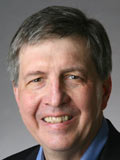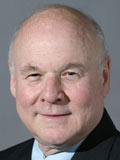
A list of the 25 most influential people in healthcare design in 2010 includes four Texas A&M College of Architecture faculty and an outstanding college alumnus who serves as executive vice president for HKS Inc., a Dallas-based architecture firm.
The list was compiled by Healthcare Design magazine’s editorial board and staff and the publishing staff at the Center for Health Design, whose members advance the idea that design can be used to improve patient outcomes in health care environments.
No other university has more than one representative on the list.
According to Healthcare Design the list is a “who's who” of the health care design industry including architects, interior designers, academics and researchers.
“These 25 people are fairly representative of today's best and brightest,” the magazine wrote.The 2010 list of most influential people in healthcare design recognizes:
The entire list is available at: http://www.healthcaredesignmagazine.com
Kirk Hamilton, an American Institute of Architecture and American College of Healthcare Architects Fellow, is interested in evidence-based design for health care and the relationship of facility design to organizational performance.
An associate professor and faculty fellow in the Center for Health Systems and Design at the A&M College of Architecture, Hamilton is a distinguished scholar and founding principal of Watkins Hamilton Ross Architects, Inc., a design firm headquartered in Houston, Texas.
Hamilton also edits the Health Environments Research & Design Journal, an interdisciplinary, peer-reviewed journal whose mission is to enhance the knowledge and practice of evidence-based health care design by disseminating research findings, discussing issues and trends, and translating research to practice.
MardelleShepley specializes in architectural design, social architecture, health care facility design, applied research, and environmental psychology. She is author of "Health Facility Evaluation for Design Practitioners," which provides information to help design professionals better understand, plan, conduct and share pre- and post-occupancy evaluations of health facilities. The scholarly yet accessible text advances the goals of evidence-based design by giving practitioners everything they need to conduct design research and enrich the knowledge base of health design.
Hamilton and Shepley co-authored "Design for Critical Care: An Evidence-Based Approach," which details best practices in intensive care facility design.
"By making the connection between research evidence and design practice, Hamilton and Shepley present a holistic approach that outlines the future for successful design for critical care settings," according to the publisher's cover notes. It's a thorough and insightful guide, the notes continue, focusing on design that has been successful and beneficial to both hospital staff and hospital patients.
Roger Ulrich is known throughout the international health care community. His theories and ideas have been changing the way buildings are designed and health care services are provided since 1984, when his landmark research paper that coined the phrase “evidence-based design” was published in Science magazine.
In 2007, Ulrich received the George Herbert Walker Bush Excellence Award for Faculty in International Research. In nominating Ulrich for the honor, Mark Clayton, professor of architecture at Texas A&M, wrote, “there are few faculty members of a department of architecture on any continent who have had as extensive an influence in scientific research as Dr. Roger Ulrich. He has inspired an entire new field of both basic and applied research that links environmental psychology to building design and performance.”
George Mann established the first architecture-for-health design studio at Texas A&M Univeristy in 1967. He and his students have participated in more than 700 socially significant architecture design projects which have enhanced the health and welfare of people in need around the world, while providing A&M students with unique opportunities to gain practical, hands-on experience through “real-world” projects yielding consequential humanitarian results.
Mann’s studios focus on case study approaches to health facilitydesign allowing students to work with actual clients andbudgets.Through an interdisciplinary approach to problem solving, the studiosencourage students to work with physicians and allied health professionalsas well as experts in all of the built environment professions.
Whether a flying ophthalmological teaching hospital or a floating critical care facility serving third-world populations, or an ultra-modern 4.1 million square-foot health-care institution serving a major Canadian city, Mann’s studio projects have earned him, his students and Texas A&M University a sterling international reputation for excellence in architecture-for-health design and notable altruistic endeavors.
In the process, Mann has educated a new generation of highly nuanced architects who specialize in designing smart, high-tech health-care facilities that nurture patient recovery while facilitating the numerous and ever-changing demands of modern medicine. Today, Mann’s former students staff health-care design studios, and are counted among the principals of the world’s leading architecture firms.
In 2003, Mann received the Texas A&M University Bush Excellence Award for Faculty in Public Service.
Craig Beale, who earned a Bachelor of Architecture degree from Texas A&M in 1971, has dedicated his career to health care architecture. Since 2000, he has directed the HKS Healthcare Group, with overall responsibility for its mission, focus and practice. During this period HKS has produced more health care construction than any other U.S. firm according to Modern Healthcare, now over $1.5 billion annually. In 2006, BD World Architecture ranked HKS the number one health care practice in the world.
A member of the American Institute of Architects’ College of Fellows, Beale has lectured nationally and internationally, having addressed more than 3,000 practitioners on topics ranging from emergency and cancer center design to health facilities of the next century.
- Posted: Jan. 13, 2011 -
Contact: Phillip Rollfing, prollfing@archone.tamu.edu or 979.458.0442.

Kirk Hamilton

Maedelle Shepley

Roger Ulrich

George Mann

Craige Beale
